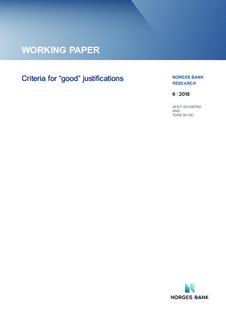| dc.description.abstract | Many institutions in a democratic society wield important power by virtue of the decisions they make. These decisions may concern individuals or have a more general impact on society. It goes without saying today that this exercise of power must be accounted for. A supreme court’s reasoning is given in its judgements. A central bank’s reasoning is given in the decision-making body’s minutes. In this paper, we develop criteria for what constitute good written justifications for a decision, not what makes a good decision per se. We look at the two institutions we know best: supreme courts and central banks. Of course, these are not the only institutions that exercise power on behalf of the state, and we also ask whether our criteria could be applied more generally. We assess a selection of supreme court judgements and monetary policy decisions in various countries qualitatively against our criteria, and find that practice largely conforms to the criteria. There are some common features between supreme courts and central banks. In recent years there has been a development in the way the judgments are written in the UK Supreme Court. Earlier, each judge wrote his votum. Now they are writing a common text. With individual writing, there were many different formulations of the normative text. It is easier for the public to relate to one legislative text. The UK Supreme Court, under the presidency of Lord Neuberger, has therefore gradually moved towards writing a joint text. John Roberts, the US Chief Justice, thought that judges should be worried when they are writing separately about the effect on the court as an institution. What about the minutes of the central banks? Professor Alan Blinder at Princeton argues that a central bank that speaks with a cacophony of voices has no voice at all. Professor Otmar Issing, the former Chief Economist and Member of the Board of the ECB, believes that there is a danger that individual minutes provide an incentive for individual members to put themselves ahead of the institution We also test empirically whether the institutions’ decisions and the justifications for these decisions are communicated in clear language. Our analysis is inspired by Bank of England chief economist Andrew Haldane’s speech “A little more conversation, a little less action”, and by the report “Bankspeak: The Language of World Bank Reports 1946-2012” by Franco Moretti and Dominique Pestre at Stanford Literary Lab. We analyse more than 6,000 central bank and supreme court decisions from the past decade and find considerable differences in length and readability across countries and institutions. The grand chamber decisions of the European Court of Human Rights are by far the longest, while the European Court of Justice employs the most complex language. The Danish central bank keeps things briefest and uses the clearest language, but also has the simplest regime to explain. The Swedish central bank’s minutes stand out as both long and complex, while the Norwegian central bank is unusually concise. Moretti and Pestre analysed the text of all World Bank reports and found quantitative indications that the language of the reports had moved in the wrong direction in terms of readability. We perform the same tests on central banks and supreme courts and find that these institutions’ language has not moved in the same negative direction. Former Bank of England governor Mervyn King argued that the design of an institution “must reflect history and experience”, and there is no doubt that each institution’s way of writing is influenced by its own history. This is what economists refer to as “path dependence”. We wonder, however, whether there is rather too much path dependence in many cases, and whether the institutions in question might benefit from looking at trends and learning from other institutions both at home and abroad. In our work on this paper, we have been particularly wary of phrases along the lines of “based on a general assessment”. Alarm bells sound whenever we see them, especially with any frequency, as they are liable to conceal rather than illuminate the true rationale. | nb_NO |

